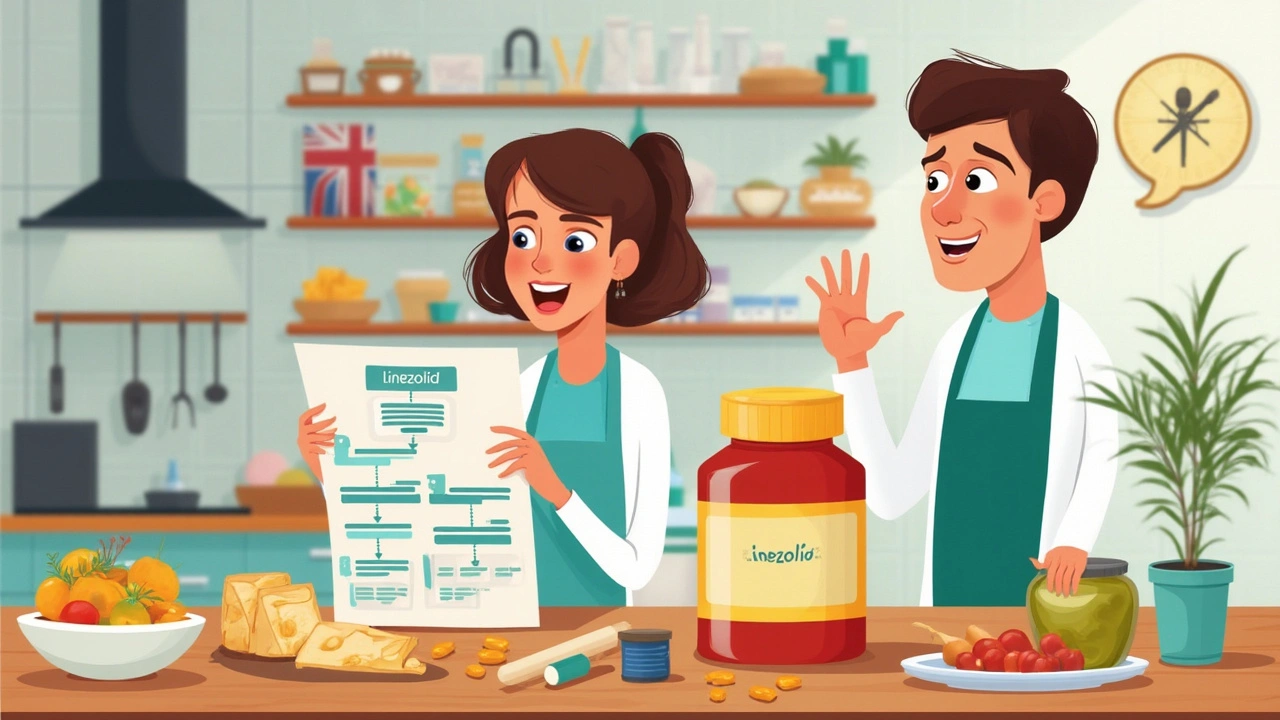If you’ve ever wondered what makes linezolid tick inside your body, you're not alone. It’s one of those antibiotics doctors reach for when regular options stop working, especially against stubborn bacteria like MRSA or VRE. But what happens after you swallow that pill or get an infusion?
Let’s get practical: linezolid gets absorbed super well, even if you just took it with breakfast. That’s not so common for antibiotics—most are picky eaters and prefer an empty stomach. This simple fact means fewer headaches about diet timing and better consistency in fighting infection.
But there’s more. How your body breaks down linezolid and how quickly it leaves your system can affect everything—dose, side effects, even how soon you start feeling better. And since linezolid can interact with some common foods and meds, knowing the basics isn’t just for doctors. Anyone using linezolid, or caring for someone who is, can really benefit from understanding what’s going on under the hood.
- What Happens to Linezolid in Your Body
- How Linezolid Fights Bacteria
- Key Factors Influencing Linezolid Effectiveness
- Practical Tips for Safe and Effective Use
- Curious Facts and What to Watch Out For
What Happens to Linezolid in Your Body
So how does linezolid actually travel through you? Right after you take it—either as a pill or through an IV—your body gets to work fast. Linezolid is almost completely absorbed from your gut, with more than 90% making its way into your system. No need to sweat about food messing with it. Whether you eat or not doesn’t change much, so just focus on not missing a dose.
Linezolid spreads everywhere—lungs, skin tissues, fluids—so it can reach those hard-to-treat infections. The neat part is, it doesn’t need to be broken down by your liver like a lot of other drugs. Instead, your body changes it a little through simple processes, and much of it leaves your system unchanged through your urine.
The half-life (that’s how long it takes for half the drug to leave your body) is pretty simple: about 5 to 7 hours in healthy adults. For most people, dosing is twice a day to keep levels steady.
| Pharmacokinetic Fact | Details |
|---|---|
| Bioavailability | >90% (excellent absorption) |
| Half-life | 5–7 hours (adults) |
| Protein Binding | ~31% |
| Main Elimination | Urine (unmetabolized and metabolites) |
Age and kidney health can change how your body handles linezolid. If your kidneys aren’t working well, or if you’re older, the drug can hang around longer. That’s why they keep an eye on your blood counts and side effects—especially with longer courses.
No need to adjust the dose just because of food, and you don’t have to worry about the type of infection affecting how your body soaks up linezolid. Its reliable absorption is one reason docs trust it so much for serious infections.
How Linezolid Fights Bacteria
So how does linezolid stop bacteria in their tracks? It goes straight for the machinery bacteria use to make proteins, called the ribosome. Most antibiotics mess with protein production in one way or another, but linezolid is a game-changer. It blocks the early stage of that process, basically flipping the stop switch before it even gets going. That’s why it works against bacteria that shrug off other drugs.
What’s special is that it blocks the 23S part of the ribosome, which means bacteria can’t build new proteins to grow or repair themselves. No proteins, no life—plain and simple. This makes linezolid a pharmacodynamics superstar, especially for infections like MRSA (methicillin-resistant Staph aureus) and VRE (vancomycin-resistant Enterococcus).
- Linezolid works against both Gram-positive cocci and some Gram-positive rods. It does not touch most Gram-negative bacteria, so it’s not a “one size fits all” solution.
- Unlike some antibiotics, it works even on bacteria that hang out inside your cells, which can be a game-changer for certain tough infections.
Check out this quick comparison with other common antibiotics:
| Antibiotic | Main Target | MRSA Coverage | VRE Coverage |
|---|---|---|---|
| Linezolid | Protein synthesis (ribosome 23S) | Yes | Yes |
| Vancomycin | Cell wall | Yes | No |
| Penicillin | Cell wall | No | No |
But there’s a catch: bacteria can develop resistance. That’s why doctors try not to use linezolid for every sniffle—overuse would lead to more linezolid-resistant bugs, which is bad news for everyone. If you ever get linezolid, know it’s usually for a good reason and not just handed out casually.
Here’s a quick tip: if infection is lurking inside hard-to-reach places, like deep inside tissue or inside cells, linezolid’s ability to reach those spots can make it a first-choice option. It also means it’s often used for pneumonia, skin infections, or infections after surgery, especially when the usual antibiotics have failed.

Key Factors Influencing Linezolid Effectiveness
You might think taking linezolid is as easy as popping a pill, but some real-world factors can make or break how well it works. Here’s what you actually need to know before you trust it to do its job.
First up: kidney and liver health. While linezolid isn’t heavy on the kidneys compared to some antibiotics, things can change if you already have liver or kidney problems. People with serious kidney issues might need closer dose monitoring. Pharmacokinetics tell us that over 30% of linezolid is cleared by the kidneys. If your kidneys are sluggish, linezolid can build up and boost side effects, like low blood counts.
Now, let’s talk about drug interactions. This isn’t like mixing a soda with pizza. Linezolid can mess with meds that raise serotonin, like some antidepressants or migraine drugs. In rare cases, this can set off serotonin syndrome—a dangerous jumble of confusion, high blood pressure, and muscle twitching. As the CDC notes:
"Patients should avoid combining linezolid with serotonergic medications due to the risk of serotonin syndrome." — Centers for Disease Control and Prevention
Your diet also plays a sneaky role here. Even though linezolid gets absorbed well regardless of what you eat, it’s got a weird thing with certain foods, especially those high in tyramine—think aged cheese, cured meats, and fermented soy products. Eating them can send your blood pressure soaring. So, best to check labels or just skip anything pickled or extra stinky for now.
What about bacteria? Not all infections are created equal. If you’re dealing with bacteria that have developed resistance to other antibiotics, linezolid is specifically designed for this. But bacteria aren’t dumb; improper dosing or stopping early gives them a free pass to evolve. Always stick to your full course unless your doc says otherwise—don’t play around with the timing.
Need a quick breakdown? Here’s a table with top factors to keep in mind:
| Factor | Impact on Linezolid |
|---|---|
| Kidney Health | Slower clearance, more side effects |
| Liver Function | Possible need for monitoring in severe impairment |
| Drug Interactions | Serotonin syndrome risk with certain meds |
| Diet (Tyramine) | Risk of high blood pressure |
| Bacterial Resistance | Reduced effectiveness if not taken as prescribed |
The bottom line? Watch your current health status, ask your doctor before adding new meds or foods, and never play fast and loose with linezolid dosing. Catching these factors early can mean the difference between a quick recovery and a medical headache you didn’t bargain for.
Practical Tips for Safe and Effective Use
Getting the most out of linezolid boils down to doing a few key things right—stuff that can make a real difference in how well it works and how safe the experience is.
- Stick to the schedule. Take linezolid at the same time each day to keep steady levels in your body. This helps prevent missed doses, which is a big reason why bacteria manage to survive and get stronger.
- Eat whatever you want… almost. Linezolid can be taken with or without food, but watch out for foods super high in tyramine. That means things like aged cheeses, cured meats, soy sauce, and even tap beer. They can cause blood pressure spikes because of how linezolid interacts with certain chemicals in the body.
- Don’t mix meds without asking. Some antidepressants and migraine meds (like SSRIs, SNRIs, or triptans) can interact badly with linezolid, leading to a risky condition called serotonin syndrome. Always double-check with your pharmacist or doctor if you’re on brain meds.
- Watch for side effects. Be on the lookout for weird bruising, tiredness, vision changes, or tingling in your hands and feet. If you feel any of this, call your doctor. Linezolid can sometimes cause blood problems or nerve issues, especially if you’re on it longer than two weeks.
- Finish the full course. Feeling better halfway through isn’t a free pass to stop. Cutting treatment short gives bacteria a shot at coming back stronger and harder to kill.
Want to know how likely side effects are? Here’s a quick breakdown based on actual clinical studies:
| Side Effect | Approximate Chance |
|---|---|
| Diarrhea | Up to 8% |
| Headache | 8% |
| Low Platelets (thrombocytopenia) | 2-10% (especially after 2+ weeks) |
| Nerve Problems (neuropathy) | Less than 1%, increases with longer use |
Keep a list of your meds with you and don’t be shy about updating your doctor about anything new you start, even if it’s an over-the-counter pain med or a dietary supplement. When it comes to antibiotics like linezolid, details matter a lot. Taking these steps keeps you safer and helps the drug work as intended.

Curious Facts and What to Watch Out For
There’s way more to linezolid than most people realize. Here’s some eye-opening stuff you might not hear in the clinic.
First up: linezolid can mess with your body’s ability to handle certain foods. It acts a bit like old-school antidepressants called MAO inhibitors. That means if you chow down a plate of aged cheese, cured meats, or anything high in tyramine, your blood pressure might spike, big time. One real-life example—someone actually had a hypertensive crisis just from eating pepperoni pizza. So, check food labels when you’re on it.
It also interacts with a bunch of common meds. You need to be super careful with things like SSRIs or other antidepressants. Mixing these can sometimes trigger a rare, but nasty, reaction called serotonin syndrome—think confusion, sweating, muscle twitching, and fast heart rate. The CDC puts it plainly:
“Concurrent use of linezolid with serotonergic psychiatric medications increases the risk for serotonin syndrome, even at standard doses.”
– Centers for Disease Control and Prevention
Here’s an at-a-glance look at common food and drug interactions to keep on your radar:
| Food/Drug | What to Watch For |
|---|---|
| Aged cheese, cured meats, soy sauce | High blood pressure, headaches |
| SSRIs, SNRIs, certain painkillers | Serotonin syndrome (mental status changes, tremors) |
| Decongestants, stimulants | Increased blood pressure, anxiety |
One more thing: unlike most antibiotics, linezolid can lower platelet counts (that means your blood might not clot as well). This is more likely if you use it for longer than a couple of weeks. You don’t have to panic, but don’t ignore nosebleeds or bruises that show up without reason—get them checked.
If you’re taking linezolid at home, keep your pharmacy’s phone number handy. Don’t mix or skip doses, and always let your healthcare provider know about every med and supplement you use. Paying attention to these odd facts isn’t just trivia—it can make a real difference in staying safe and getting better.





Alright, let’s strip this down to the cold, hard facts because the article tries to sound friendly while ignoring the gritty details. Linezolid is indeed well‑absorbed, but the post glosses over the fact that its pharmacokinetics are highly variable in patients with renal impairment – a point that can’t be ignored when dosing. The half‑life shoots up to 10‑12 hours in those cases, yet the author pretends a one‑size‑fits‑all schedule works for everyone. They also downplay the serotonin syndrome risk, which isn’t just a footnote; it’s a real, potentially fatal interaction with common SSRIs. Let’s not forget that the drug’s protein binding is only about 31%, meaning tissue penetration is great, but the article fails to mention the need for therapeutic drug monitoring in prolonged therapy. The tables are nice, but they lack context about how age‑related changes in hepatic function could alter metabolism. Moreover, the claim that food doesn’t matter is oversimplified – tyramine‑rich foods can trigger hypertensive crises, and the post barely scratches the surface. The author’s tone is all smiles, but the reality is that linezolid can cause thrombocytopenia in up to 10% of patients on extended courses, requiring regular CBC checks. The piece also omits the cost factor; this drug isn’t cheap, and insurance coverage can affect adherence, which directly impacts resistance development. Speaking of resistance, the article mentions it in passing but doesn’t stress the stewardship implications of overuse. One more thing: the IV formulation has a different volume of distribution and may need dose adjustments that the post completely skips. Finally, the author’s recommendation to “just take it with or without food” is misleading – patients need concrete guidance, not vague reassurance. All in all, while the basics are there, the nuances are buried, and that’s a disservice to anyone actually taking this medication.
Thanks for laying out those concerns, Suraj. I think it’s crucial to highlight the monitoring steps, especially for blood counts, because catching thrombocytopenia early can prevent serious bleeding. Also, the point about tyramine‑rich foods shouldn’t be brushed off; a simple reminder can save a patient from a hypertensive episode. While the article is a solid overview, adding a short checklist for patients would make it far more practical. Let’s keep the conversation supportive and make sure readers walk away with clear, actionable advice.
Here’s the thing most people don’t see: the pharma giants love to hide the nasty side effects behind glossy brochures. Linezolid’s interaction with serotonin‑boosting drugs is just the tip of the iceberg; there are hidden pathways that can mess with your immune system in ways regulators won’t admit. The post tries to sound neutral, but the reality is that the drug’s safety data is still being re‑evaluated behind closed doors. If you think the cheap ‘one‑size‑fits‑all’ dosing is safe, you’re buying into the same narrative they used for other over‑promoted antibiotics. Keep your eyes open, and don’t trust the marketing fluff.
Whoa, Sean, you’ve gone full conspiracy mode there. While it’s true that big pharma isn’t always transparent, the clinical trials for linezolid did flag the serotonin issue, and it’s now in the label warnings. The drug’s benefits against MRSA and VRE are real and have saved countless lives. Still, a balanced view that warns patients without stoking panic is the way to go. Let’s not forget that proper therapeutic drug monitoring can mitigate many of those hidden risks.
Great summary of the key points!
While I appreciate the concise wrap‑up, I must point out that reducing such a complex pharmacological profile to a ‘great summary’ risks oversimplification. The nuances of linezolid’s mechanism, especially its selective inhibition of the 23S rRNA of the bacterial ribosome, deserve a deeper dive. Moreover, the potential for inducing serotonin syndrome isn’t merely a footnote; it’s a critical safety consideration that warrants explicit emphasis. And let’s not ignore the socioeconomic dimension – access to therapeutic drug monitoring isn’t universal, which can exacerbate disparities in outcomes. In short, brevity is admirable, but depth is essential for informed decision‑making.
It is imperative that we, as responsible stewards of antimicrobial therapy, underscore the moral obligation to avoid the frivolous use of linezolid. Misuse not only fuels resistance but also endangers vulnerable patients who truly need this last‑line agent. Every prescription should be justified with a clear microbiological indication, and clinicians must vigilantly monitor for adverse effects, especially hematologic abnormalities. The public must be educated that antibiotics are not a casual cure‑all; they are powerful tools that demand respect. Let us all commit to preserving their efficacy for future generations.